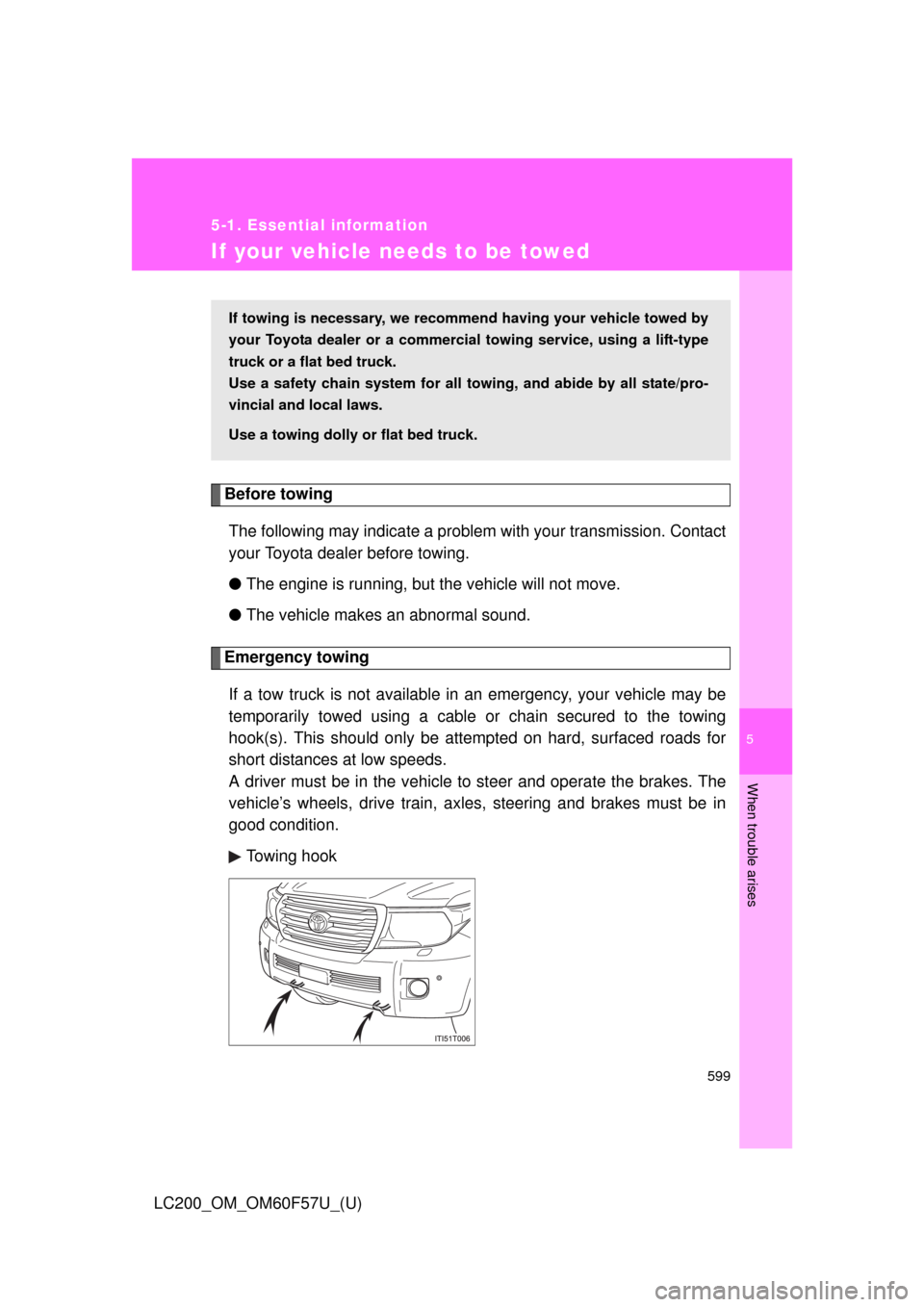Page 599 of 720

5
When trouble arises
599
5-1. Essential information
LC200_OM_OM60F57U_(U)
If your vehicle needs to be towed
Before towing
The following may indicate a problem with your transmission. Contact
your Toyota dealer before towing.
●The engine is running, but the vehicle will not move.
●The vehicle makes an abnormal sound.
Emergency towing
If a tow truck is not available in an emergency, your vehicle may be
temporarily towed using a cable or chain secured to the towing
hook(s). This should only be attempted on hard, surfaced roads for
short distances at low speeds.
A driver must be in the vehicle to steer and operate the brakes. The
vehicle’s wheels, drive train, axles, steering and brakes must be in
good condition.
Towing hook
If towing is necessary, we recommend having your vehicle towed by
your Toyota dealer or a commercial towing service, using a lift-type
truck or a flat bed truck.
Use a safety chain system for all towing, and abide by all state/pro-
vincial and local laws.
Use a towing dolly or flat bed truck.
Page 600 of 720
600 5-1. Essential information
LC200_OM_OM60F57U_(U)
■Emergency towing procedure
The engine must be in ACCESSORY mode (engine off) or IGNI-
TION ON mode (engine running).
Put the four-wheel drive control switch in “H4”. (The center differen-
tial is unlocked.)
Put the shift lever in “N”.
Release the parking brake.
CAUTION
■While towing
●Use extreme caution when towing the vehicle.
Avoid sudden starts or erratic driving maneuvers which place excessive
stress on the emergency towing hook and the cable or chain. Always be
cautious of the surroundings and other vehicles while towing.
●If the engine is not running, the power assist for the brakes and steering
will not function, making steering and braking more difficult.
NOTICE
■To prevent causing serious damage to the transmission
●Never tow this vehicle with the wheels on the ground.
●Use only the front emergency towing hooks or towing eyelets (depending
on vehicles) when towing your vehicle.
STEP1
STEP2
STEP3
STEP4
Page 601 of 720
5
When trouble arises
601 5-1. Essential information
LC200_OM_OM60F57U_(U)
Towing with a sling-type truck
NOTICE
■To prevent body damage
Do not tow with a sling type truck, either from the front or rear.
Page 602 of 720
602 5-1. Essential information
LC200_OM_OM60F57U_(U)
Towing with a wheel lift-type truck
From front
Use a towing dolly under the rear
wheels.
From rear
Use a towing dolly under the
front wheels.
NOTICE
■To prevent causing serious damage to the transmission
Never tow this vehicle wheels on the ground.
■To prevent damaging the vehicle
●Do not tow the vehicle with the “ENGINE START STOP” switch OFF.
The steering lock mechanism is not strong enough to hold the front wheel
straight.
●When raising the vehicle, ensure adequate ground clearance for towing at
the opposite end of the raised vehicle. Without adequate clearance, the
vehicle could be damaged while being towed.
Page 603 of 720
5
When trouble arises
603 5-1. Essential information
LC200_OM_OM60F57U_(U)
Using a flat bed truck
If your Toyota is transported by a
flat bed truck, it should be tied
down at the locations shown in
the illustration. When attaching
the hooks to the rear of the vehi-
cle, make sure to attach them to
the inside of the vehicle.
If you use chains or cables to tie
down your vehicle, the angles
shaded in black must be 45.
Do not overly tighten the tie
downs or the vehicle may be
damaged.
NOTICE
■To avoid serious damage to your vehicle
Do not use the rear emergency towing
hook.
ITY51C023
Page 643 of 720
5
When trouble arises
643 5-2. Steps to take in an emergency
LC200_OM_OM60F57U_(U)Firmly tighten each nut two or
three times in the order shown in
the illustration.
Tightening torque:
97 ft•lbf (131 N•m, 13.4 kgf•m)
Reinstall the wheel ornament.
Stowing the flat/spare tire, jack and tools
Lay down the tire with the outer
side facing up, and install the
holding bracket.
Raise the tire.
Pull the tire towards the rear of the vehicle when raising. After
raising, visually check that tire is not interfering with compo-
nents.
Stow the tools and jack securely, and replace all covers.
STEP4
STEP5
STEP1
STEP2
STEP3
Page 646 of 720

646 5-2. Steps to take in an emergency
LC200_OM_OM60F57U_(U)
NOTICE
■Do not drive the vehicle with a flat tire
Do not continue driving with a flat tire.
Driving even a short distance with a flat tire can damage the tire and the
wheel beyond repair.
■When stowing the flat tire
Ensure that there is no object caught between the tire and the vehicle
underbody.
■When replacing the tires
When removing or fitting the wheels, tires or the tire pressure warning
valve and transmitter, contact your Toyota dealer as the tire pressure
warning valve and transmitter may be damaged if not handled correctly.
■To avoid damage to the tire pressure warning valves and transmit-
ters
When a tire is repaired with liquid sealants, the tire pressure warning
valve and transmitter may not operate properly. If a liquid sealant is
used, contact your Toyota dealer or other qualified service shop as soon
as possible. Make sure to replace the tire pressure warning valve and
transmitter when replacing the tire.
(P. 545)
Page 662 of 720
662 5-2. Steps to take in an emergency
LC200_OM_OM60F57U_(U)
CAUTION
■When attempting to free a stuck vehicle
If you choose to push the vehicle back and forth to free it, make sure the sur-
rounding area is clear, to avoid striking other vehicles, objects or people. The
vehicle may also lunge forward or lunge back suddenly as it becomes free.
Use extreme caution.
■When shifting the shift lever
Be careful not to shift the shift lever with the accelerator pedal depressed.
This may lead to unexpected rapid acceleration of the vehicle that may
cause an accident resulting in death or serious injury.
NOTICE
■To avoid damage to the transmission and other components
●Avoid spinning the rear wheels and depressing the accelerator pedal more
than necessary.
●If the vehicle remains stuck even after these procedures are performed,
the vehicle may require towing to be freed.